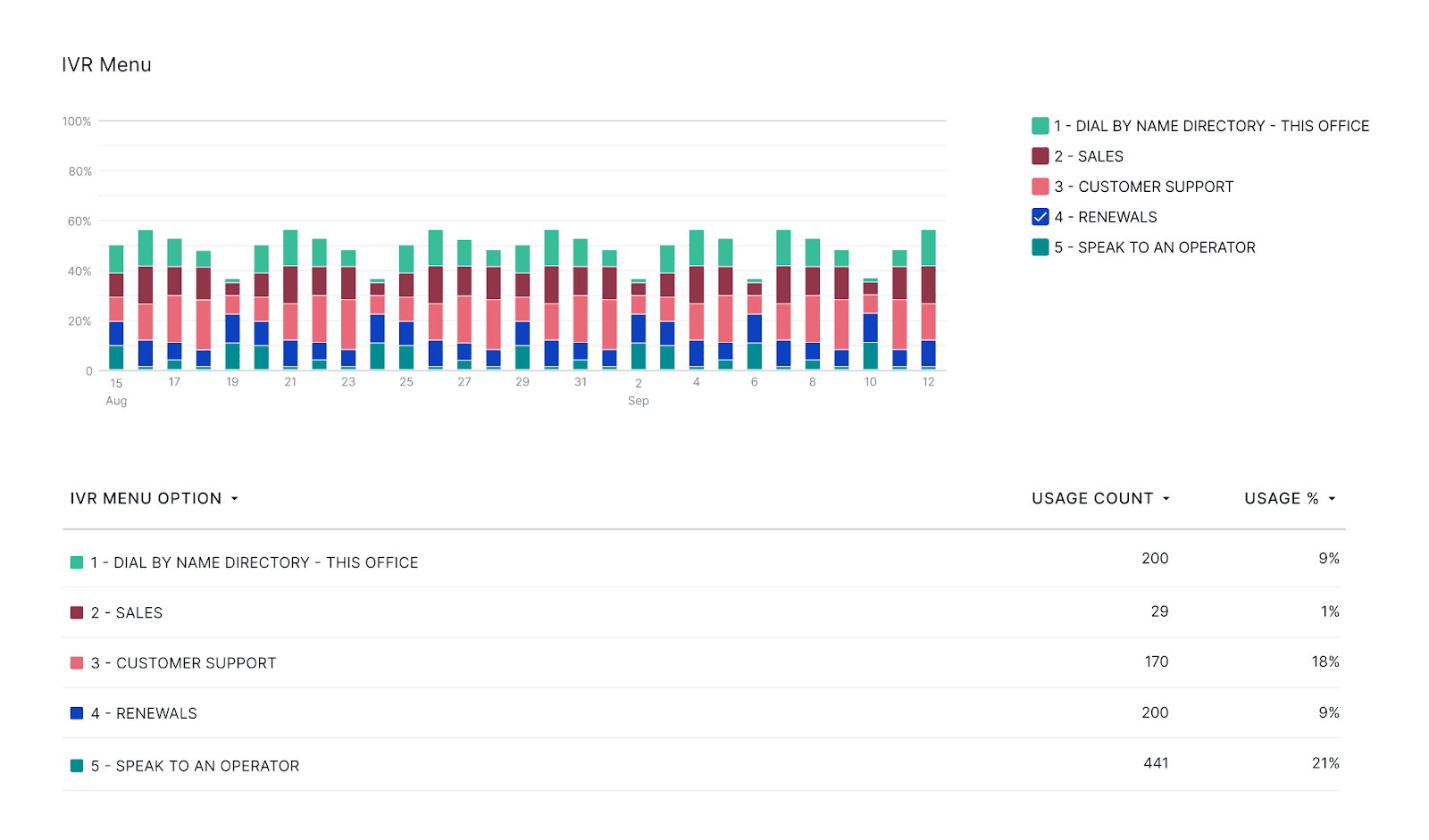
Tags
Share
IVA vs. IVR: Key differences and how to choose between the two
Today, more and more businesses need to provide efficient customer service around the clock.
Enter Intelligent Virtual Assistants (IVAs) and Interactive Voice Response (IVR) systems—two powerful tools that can help automate and manage customer interactions over the phone.
But while both aim to improve customer experience, they do differ significantly in terms of functionality, technology, and capabilities. Understanding the key differences between IVAs and IVRs is crucial when deciding which is the best fit for your business needs. Let’s dive in.
What is an Intelligent Virtual Assistant (IVA)?
An Intelligent Virtual Assistant, or IVA, is an Ai-powered software designed to simulate conversational interactions—as if customers were talking to a human agent.
Unlike basic IVR systems, which rely on simple voice prompts and preset menus, IVAs offer much more advanced capabilities, such as natural language processing (NLP), machine learning, and context-aware conversations. This lets them understand user intent more accurately, adapt to different communication styles, and provide more personalized interactions.
How does IVA work?
IVAs use conversational Ai to understand and process human language, offering personalized responses based on the context of the conversation.
When a customer or prospect interacts with an IVA, it can interpret spoken or written input, understand the query, and provide the right responses—like a human agent or Ai virtual assistant. It’s also capable of handling more complex requests and even learning from previous interactions to improve responses over time.
Key features of IVA
Here are some features to be aware of when it comes to IVA solutions:
Natural Language Understanding (NLU): IVAs understand human language in its natural, conversational form. This is what makes it feel less rigid and more dynamic when talking to an Ai-powered IVA as opposed to an IVR.
Multichannel support: IVAs can work across different platforms such as phone calls, live chat, and social messaging.
Personalization: By leveraging customer data, IVAs can offer personalized experiences, such as providing tailored product recommendations or account information.
Self-learning: Through machine learning, IVAs continuously improve and adapt their responses over time based on user interactions.
What is Interactive Voice Response (IVR)?
IVR, or Interactive Voice Response, is a technology that allows customers to interact with a system through pre-recorded voice prompts and DTMF (dual-tone multi-frequency) keypad inputs. Unlike IVA software, IVRs rely on rigid menus and offer fewer interactive capabilities, making them a more straightforward tool for handling basic queries and tasks.
How does IVR work?
When a customer calls a business, they are greeted by the phone system or call center IVR that presents a set of options.
These options are typically arranged in a menu format. (For example, “Press 1 for sales, press 2 for support…”) The caller can then make their selection by pressing the appropriate number on their keypad or speaking the number.
The system then routes the caller to the relevant department or provides the requested information. While IVR is efficient, it lacks the personalized and conversational abilities of an IVA solution.
Key features of IVR
Here are some of IVR’s core features:
Menu-based navigation: IVRs rely on a predefined set of options that guide the customer to the correct department or information.
Automated call routing: IVRs can direct calls to the appropriate agent or department based on the customer’s selection.
Basic data collection: IVRs can collect basic information from the customer, such as account numbers or order details, to process simple requests.
Voice recognition: Some advanced IVR systems feature speech recognition, but these are often limited compared to the capabilities of an IVA.
Some IVR and IVA software even provides built-in analytics to help you track call center KPIs. For example, Dialpad comes with a dashboard that shows you which IVR menu options are being used most and least frequently, so you can optimize your menu options based on what your callers are looking for:

IVA vs. IVR
Understanding the key differences between an IVR and IVA solution is essential when deciding which one is best for your business. While both solutions can automate customer interactions, they vary significantly in terms of technology, functionality, and the caller experience. Choosing the right system—whether it’s an IVR or a more advanced call center IVA—can have a significant impact on how you engage with your customers and streamline support processes.
Let’s break down the most important distinctions.
What’s the difference between IVR and IVA?
There are three main differences between these two types of call-handling systems:
Complexity and capability: IVAs offer advanced Ai-driven capabilities such as natural language processing and personalized interactions. IVRs, on the other hand, are rule-based and follow a rigid, menu-driven structure.
Customer experience: IVAs provide a more fluid, conversational experience, while IVRs can feel transactional and impersonal, relying heavily on pre-set prompts.
Automation level: IVAs are capable of handling more complex queries and tasks autonomously, while IVRs typically require human intervention for anything outside of basic functions.
Pros and cons of IVA and IVR
Pros | Cons | |
IVA | A smoother customer experience: IVAs’ conversational nature makes interactions feel more personalized and like you’re talking to another person. 24/7 availability: IVAs can operate round-the-clock, ensuring your customers receive support whenever they need it. Efficient handling of complex queries: IVAs can manage complicated requests, which reduces staffing costs.. | Higher initial investment: Implementing an IVA can be more time- and resource-intensive because you may want to spend some time training the Ai tool on your company’s specific processes and workflows. Requires constant monitoring: While IVAs learn over time, they still require oversight to make sure they’re automating things properly. |
IVR | More affordable: IVRs are generally less expensive to implement compared to IVAs because they’re simpler tools. Good for basic tasks: IVRs are great at handling basic queries and tasks like balance checks or order status updates. Easy to implement: IVR systems tend to be simpler to set up and integrate with existing phone systems. | Limited flexibility: IVRs can only handle a fixed set of commands, making them less adaptable to customer needs. Impersonal: The menu-based system can be frustrating, as callers have to navigate throughlayers of options. |
Use cases
Now, let’s look at some examples of use cases for both tools:
IVA
A customer needs assistance with troubleshooting a complex product issue or wants personalized recommendations based on past purchases. An IVA can provide in-depth assistance and offer relevant suggestions.
A customer wants to book a service appointment or make a reservation at a restaurant. The IVA can handle the entire process, offering available time slots, confirming the booking, and sending reminders.
A customer wants to inquire about specific account details like billing history, membership status, or subscription preferences. The IVA can access the customer’s data, process the query, and even help modify account details, providing a more personalized experience compared to a traditional IVR system.
IVR
A customer simply needs to check their account balance or schedule a delivery. An IVR system can efficiently handle these tasks with minimal human involvement.
A customer needs to speak to the support team for a technical issue but doesn’t know which department to contact. The IVR system can direct the call based on a few simple menu options, which saves time and reduces the risk of misdirected calls.
A customer wants to track the status of a recent order or request a delivery update. The IVR system can retrieve the order status and provide relevant information quickly, without requiring agent intervention.
How to choose between IVR and IVA
Choosing between an IVR and an IVA depends on several factors related to your business needs, customer expectations, and budget. Here’s how to make the right decision:
Evaluate your business needs and customer expectations
If your business needs to handle complex inquiries or provide a more personalized experience, an IVA is likely a better fit.
For example, if your customers often need support that involves multiple steps or context-specific answers, an IVA could manage these tasks more effectively.
On the other hand, if most of your customer interactions are routine and can be efficiently handled through simple choices (like checking the order status or account balance), an IVR system could be enough.
💡 Dialpad tip:
Start by mapping out the types of customer interactions you handle most frequently and identify if they require personalization or can be streamlined with automated menus.
Consider budget and resource allocation
IVAs tend to be more expensive due to their advanced Ai technology, especially when you factor in setup, customization, and maintenance costs.
If your budget is tight, it might make sense to start with an IVR solution and gradually explore more advanced features as your business grows.
If you’re working within a limited budget, consider piloting an IVR solution first and monitoring customer feedback to determine if you need more advanced IVA features offered later on.
Assess compatibility with the rest of your tech stack
The IVR or IVA system you choose should integrate seamlessly with your existing infrastructure. While IVR systems are easier to implement and integrate with legacy systems, IVAs may require more advanced technological compatibility, especially when it comes to connecting with customer relationship management (CRM) tools, phone systems, and/or contact centre platforms.
Before choosing a solution, assess your current technology stack and consult with your IT team to ensure the chosen system will integrate smoothly with your existing platforms.
Factor in long-term scalability
Consider the growth trajectory of your business and how the system you choose will scale as your customer service needs expand across different channels.
While IVR systems are easy to scale for simple tasks on phone calls, they’re not designed to handle interactions on digital channels like social messaging or live chat. An IVA, on the other hand, is better suited for managing complex and personalized interactions across multiple platforms, offering a more seamless experience on voice, chat, and social media.
IVR vs. IVA: Which is best for your business?
When it comes to call-handling tools, the right choice for your business depends on your specific needs and goals.
While IVRs are tried-and-tested solutions for handling basic tasks efficiently, IVAs offer cutting-edge Ai-driven capabilities that elevate your customer experience to new heights—without scaling up costs.
See how companies like HomeStead and Tucows improved their IVR flows, reduced average speed to answer, and improved the customer experience with Dialpad.
Looking for a good IVR tool that’s built into your phone system?
Sign up for a free trial of Dialpad Connect to try out the IVR feature, or book a demo with our team!

